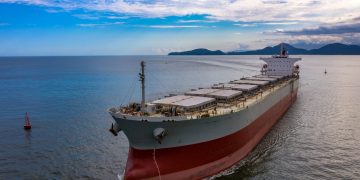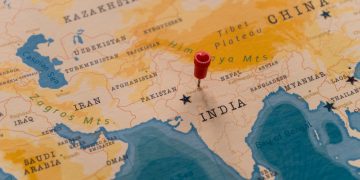While the voting procedure for the 2018 SAFETY4SEA Awards is open, Mr. Peter Broadhurst, SVP Safety and Security, Inmarsat Maritime , talks about company’s ‘Fleet Safety’ service for which Inmarsat has been nominated in the ‘Technology’ category alongside a number of other distinguished nominees. As explained, the service is a new addition toward GMDSS modernization, in compliance with IMO’s mandatory performance standards. Furthermore, Mr. Broadhurst calls for more innovation to make vessels safer, more efficient and greener and do the extra mile beyond compliance. As such, the company also offers safety services to vessels that do not come under SOLAS, helping smaller merchant, fishing, and leisure vessel owners and crew.
SAFETY4SEA: Your organization has been shortlisted for the 2018 SAFETY4SEA Awards in the ‘Technology’ category alongside a number of other distinguished nominees. What is the background behind this nomination/shortlisting?
Peter Broadhurst: Inmarsat has been driving forward with Global Maritime Distress Safety System modernisation and Fleet Safety is its new generation technology supporting a step change in the capability of this public service for seafarers. In May 2018, Inmarsat secured approvals from the Maritime Safety Committee confirming that Fleet Safety meets mandatory performance standards for GMDSS set by the International Maritime Organization.
Fleet Safety includes the new SafetyNet II and RescueNet architectures for Maritime Safety Information messaging, and a new Maritime Safety Terminal to enable the data-rich capabilities that align with developments in satellite connectivity, including Distress Chat.
S4S: What is the key feedback from your existing & prospective clients on the barriers and drivers towards a more technology friendly future?
P.B.: The imperatives for saving lives and saving money are different, but Maritime Rescue Coordination Centres nonetheless need to operate within budgets. For GMDSS, Fleet Safety is offered free at the point of use. In order to sustain the messaging architecture, Maritime Safety Information (MSI) broadcasts are charged to the authorities overseeing NAV areas on a usage basis, but it is critical that these costs too are kept to a minimum.
As a web-based platform, SafetyNet II – for example – introduces broadcast scheduling, monitoring, message cancellation, multiple text input and read-receipts without MRCCs having to invest in specialised hardware or divert stretched resources to IT upkeep. The system has also been designed to be intuitive for users.
S4S: Do you have any new projects on the pipeline and/or plans, related with your safety performance that you would like to share with the industry?
P.B.: Here, we’d like to emphasise the way SafetyNet II lays the foundation for the delivery of richer safety-critical information that will enhance next generation GMDSS. As a secure web-based service, SafetyNet II is much easier to use for MSI and SAR broadcasts, which will reduce the risk of erroneous information reaching vessels. It also enables the originator to monitor the status of every message, confirming if it has been sent, scheduled or cancelled, as well as giving confirmation that the messages have been broadcast correctly. Additional functionality such as enhanced scheduling of messages and repetition have already proved to save valuable time within the operation centres. The enhancements will also improve messaging capabilities between ships and law enforcement agencies, where incident details are also immediately broadcast.
S4S: If you could change one thing about the shipping industry, what would it be and why?
P.B.: To be more innovative, many companies are unwilling to change due to existing processes and conservative opinions and reluctant to change the status quo. Innovation will help save lives at sea and make vessels safer, more efficient and greener.
S4S: What is your key message for enhancing safety culture onboard?
P.B.: We are immensely proud that, as part of the modernisation of the GMDSS for the digital age, the IMO has given its formal approval to Fleet Broadband and Fleet One, but Inmarsat would like to underline that we take our safety responsibilities far beyond mandatory provisions. We have already launched FleetBroadband and Fleet One voice safety services for vessels that do not come under SOLAS, for example. It gives smaller merchant, fishing, and leisure vessel owners and crew – and their loved ones – peace of mind to know that they can call for help no matter where in the world they are or how bad the weather conditions. The 505 Emergency Calling facility means they need only dial ‘505’ on their satellite terminal handset to be put directly through to a Maritime Rescue Coordination Centre (MRCC). They can also access Urgency Priority, a two-digit code for medical advice or assistance. For these reasons, at Inmarsat we are also proud to say that safety is in our DNA.
You may cast your vote for Inmarsat at 2018 SAFETY4SEA Awards dedicated webpage till 7th of September 2018!

The views presented hereabove are only those of the author and not necessarily those of SAFETY4SEA and are for information sharing and discussion purposes only.

































































